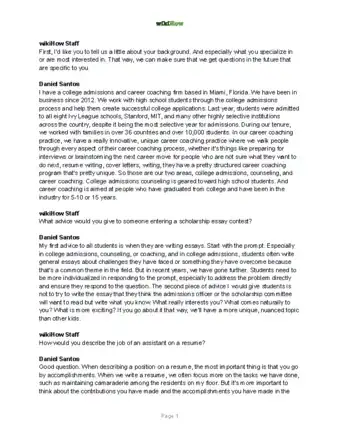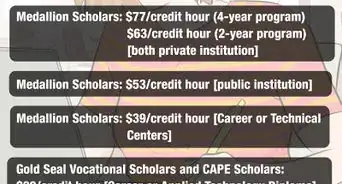This article was co-authored by Daniel Santos. Daniel Santos is a College Admissions & Career Coach and Prepory's co-founder and CEO. Prepory is a leading college admissions consulting firm that has guided over 9,000 students from 35 countries through the US college admissions process. Prepory is a member of the National Association for College Admissions Counseling and a trusted admissions counseling partner to several competitive high schools across Florida. Prior to founding Prepory, Daniel worked at various leading law firms and the United States House of Representatives. Daniel has been featured as a college admissions and career coaching expert across several major publications, including the Wall Street Journal, FORTUNE, and The Harvard Crimson.
There are 12 references cited in this article, which can be found at the bottom of the page.
This article has been viewed 27,767 times.
A bursary is a type of scholarship that’s commonly issued by learning institutions in the UK and other parts of Europe. Whereas normal scholarships are awarded on the basis of academic performance, bursaries are made available to prospective students who are confirmed to be in financial need. To apply for a bursary successfully, you’ll need to be able to prove that you don’t have the means to pay for your or your child's education on your own.
Steps
Qualifying for a Bursary
-
1Find out whether a given institution offers a bursary program. Not all schools provide funds for fee relief. To learn if the one you or your child are hoping to attend does, call the admissions office or visit the enrollment section of the institution’s website for more information. There, you’ll find answers to whatever questions you may have about the process.[1]
- Run a quick search to pull up a comprehensive list of schools and universities near you that advertise bursary programs.[2]
- If you or your child are already enrolled in a school that doesn't offer fee relief, consider transferring to another school for future terms courses.
Tip: If you’ll be relying on a bursary to pay for your education, it’s a good idea to research and apply to multiple schools to hedge your bets of being approved.
-
2Apply to your school of choice. Once you’ve identified an institution that offers non-performative financial assistance, your next step is to submit a formal application. Bursaries are typically only granted to students aged 16 and up who are currently enrolled or have begun the formal application process and are awaiting notification of acceptance.[3]
- In some cases, students who are between the ages of 16-19 may have to have a parent submit an application on their behalf.[4]
- When applying to university, you’ll need to provide copies of your or your child's final academic records for Grades 11 and 12.
- You don’t need to actually be enrolled at a certain school in order to apply for a bursary from them. By the same token, you may seek a bursary from a school that you're currently enrolled in even if you haven't applied or qualified previously.
Advertisement -
3Read up on the school’s bursary qualification standards. Eligibility guidelines can vary from one program to the next. Generally, however, your chances of approval will be decided by your income level and inability to afford things like tuition, lodging, and materials on your own.[5]
- The total expense that an institution is willing to cover might also depend on other factors, such as your or your child’s grade level, field of study, course load, or area of residence.[6]
-
4Consider applying for a scholarship if you're in good academic standing. If you or your child have historically tested well or received high marks, there’s a chance you could qualify for a traditional scholarship instead of a bursary. This could be a lifesaver if you don’t meet the financial requirements for a bursary but still need help paying for school.[7]
- Scholarships are often awarded based on past academic performance or the results of a rigorous entrance exam.
- Exceptional marks could qualify you or your child for both an academic scholarship and a bursary. Between the two, you could manage to get as much as 100% of your school-related expenses covered.
- Bursaries are a non-performative source of funding, which means things like marks aren't important as long as the school thinks you or your child has something to offer.[8]
Completing the Application Process
-
1Check the school’s application deadlines before applying. Review the financial aid information listed on the institution’s website to find the cut-off date for the bursary you’re seeking. You won’t be able to submit an application or be considered for fee relief after this time.[9]
- Most schools ask that students have their bursary applications in by the end of the preceding term. If you need help paying for Spring 2020, for example, you’ll need to submit your application no later than the final weeks of Fall 2019.
- Don’t wait until the last minute to apply. Due to high demand, bursaries are usually fulfilled on a first come, first served basis.[10]
-
2Create an account for the school’s online services system. These days, most bursary applications are managed digitally. Visit the registration or bursary application section of the website of the school you’re applying to and click on the option to create a new account. You’ll be prompted to select a custom username and password in order to log in.[11]
- If you or your child are already enrolled at the school you’re applying to, you may also need to enter certain student credentials or other information when you register.
- It might be possible to apply in person or via mail if you don’t have internet access. Get in touch with the school’s admissions office to request a physical application and kickstart the process.
-
3Fill out and submit a bursary application form. Provide your or your child’s full name, birth date, and current address. Then, specify the recipient student's grade level, field of study, and the particular bursary you’re applying for (if they’re offered individually). The form will also ask for an email address and phone number at which you can reliably be reached.[12]
- If it’s your first time applying for a bursary, the institution may require you to attach some form of personal identification, such a driver’s license, birth certificate, or passport.[13]
-
4Furnish whatever financial documents the institution requests. Along with your application, you’ll be expected to send in certain records that confirm your need for financial assistance. These may include income-related files like tax forms or bank statements, property value assessments, and copies of any pensions, savings, and other assets you possess.[14]
- You could even be contacted by a bursary officer to schedule a time for a home inspection if the school thinks it’s necessary to verify your financial situation.[15]
- To be approved for a bursary, you must be able to demonstrate your need for financial assistance on paper.
Tip: Every institution handles the financial assessment phase a little differently. Do your best to produce whatever documents you're asked for in short order.
Claiming Your Bursary Funds
-
1Wait to hear about the status of your application. After you send off your application and all other relevant documents, they’ll be processed by a special committee that’s responsible for deciding which students are qualified for assistance. It could take weeks or even months for them to get back to you, so be patient. You’ll be notified by email about whether your application has been approved or rejected.[16]
- Check your email regularly to make sure you don’t miss any important updates.
- In the event that your application is denied, you won't be eligible to receive financial aid for any classes you or your child attend. Furthermore, you'll have to wait until the following course or term to apply for a bursary again.
-
2Be prepared to sit for a follow-up interview if asked. In the majority of cases, the bursary committee will simply review your information in light of the institution’s eligibility guidelines and make a determination. At some schools, a bursary officer may request to meet with you in person to discuss the details of your application or financial records.[17]
- If you’re called in for an interview, it will most likely be to confirm certain details or clear up some small inconsistency.
- Parents of prospective students may be interviewed to answer complex financial or legal questions that the student can't.
-
3Check your student account for your bursary refund. The funds that you or your child are awarded may be credited to a school account, or it may be sent to you directly in the form of a check or reimbursement certificate. This money can be used to pay for tuition, reserve lodging, or buy books, uniforms, and other materials as outlined in the provisions of the specific bursary.[18]
- If you receive a reimbursement certificate through the institution’s online services or email, you’ll need to print it out and present it to a cashier in person at the school before the money is actually handed over to you.
-
4Reapply for your bursary as needed at the end of the specified period. Some schools require students to apply for bursaries individually after each course or term completed. Be sure to get your or your child's application in by the due date listed on your school’s website to continue receiving the help you need. Your child may also be able to apply on their own if they reach the minimum required age by the time the deadline rolls around.[19]
- The expenses offset by subsequent reimbursements may differ according to the institution’s policies—you or your child might receive a 90% bursary for one course or term and only 70% for the next.[20]
- You’re more likely to be approved for additional relief if you or your child work hard and make an effort to remain in good academic standing.
Warning: There’s no guarantee that you’ll be able to secure a bursary a second time, even if your financial situation hasn’t changed.
Warnings
- Keep in mind that bursaries are intended as a supplementary form of financial aid. As a result, they may not pay 100% of your tuition or other school-related expenses.⧼thumbs_response⧽
Expert Interview

Thanks for reading our article! If you'd like to learn more about a bursary, check out our in-depth interview with Daniel Santos.
References
- ↑ https://www.independentschoolparent.com/lifestyle/finance/bursary-and-scholarship/
- ↑ https://www.thescholarshiphub.org.uk/blog/how-find-scholarships-grants-and-bursaries-university
- ↑ https://careerwise.co.za/how-to-apply-for-a-bursary/
- ↑ https://www.gov.uk/1619-bursary-fund
- ↑ https://www.sfu.ca/students/financialaid/undergrad/bursaries.html
- ↑ https://www.gov.uk/nhs-bursaries/eligibility
- ↑ https://www.independentschoolparent.com/lifestyle/finance/bursary-and-scholarship/
- ↑ http://www.registrar.uwo.ca/student_finances/bursaries.html
- ↑ http://www.sfu.ca/students/financialaid/deadlines.html
- ↑ https://careerwise.co.za/how-to-apply-for-a-bursary/
- ↑ https://myaccount.nhsbsa.nhs.uk/Pages/Login.aspx
- ↑ https://careerwise.co.za/how-to-apply-for-a-bursary/
- ↑ https://www.gov.uk/nhs-bursaries/how-to-claim
- ↑ https://www.independentschoolparent.com/lifestyle/finance/bursary-and-scholarship/
- ↑ https://www.thetimes.co.uk/article/schools-visit-homes-to-prevent-the-rich-from-taking-bursaries-9r6llwrbn
- ↑ https://www.gov.uk/nhs-bursaries/how-to-claim
- ↑ https://www.independentschoolparent.com/lifestyle/finance/bursary-and-scholarship/
- ↑ https://www.sfu.ca/students/financialaid/undergrad/bursaries.html
- ↑ https://www.gov.uk/1619-bursary-fund/how-to-claim
- ↑ https://www.independentschoolparent.com/lifestyle/finance/bursary-and-scholarship/







































































